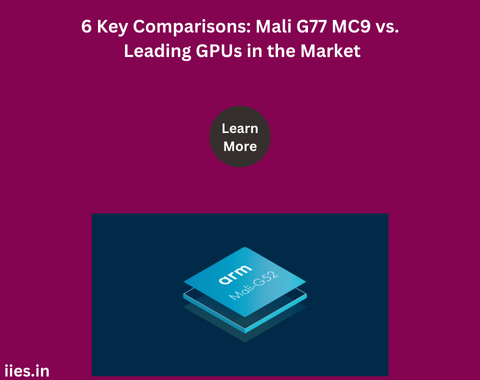1. Architecture: Valhall vs. Others
The Mali G77 MC9 is built on Arm’s Valhall architecture, which represents a significant leap from its predecessor, the Bifrost architecture. Valhall focuses on enhancing energy efficiency while delivering superior performance, making it a critical component in the mobile GPU landscape.
In comparison, other GPUs like the Adreno 650 (found in Qualcomm’s Snapdragon 865) and Apple’s A13 Bionic GPU utilize their own proprietary architectures. The Adreno 650 is built on an architecture that emphasizes power efficiency and gaming performance, while Apple’s GPU is tightly integrated with its A-series chip, optimizing performance for iOS.
The Valhall architecture’s biggest advantage lies in its ability to provide a 30% improvement in performance density and energy efficiency over Bifrost. This makes the Mali G77 MC9 particularly well-suited for high-end mobile devices where battery life and sustained performance are critical. However, while Valhall brings improvements, it still has to contend with the highly optimized and proprietary architectures of competitors like Apple, which are designed specifically for their ecosystems.
2. Performance: Real-World vs. Theoretical
When it comes to raw performance, the Mali G77 MC9 holds its own against other GPUs, especially in scenarios involving high-end mobile gaming and AI-driven tasks. The MC9 configuration, with its 9 cores, offers a good balance between power consumption and graphical output.
In synthetic benchmarks, the Mali G77 MC9 performs admirably, often coming close to or even surpassing the Adreno 650 in specific tasks like machine learning inference and some gaming scenarios. However, in real-world performance, especially in gaming, the Adreno 650 often has an edge due to Qualcomm’s focus on optimizing gaming through its software ecosystem and features like Snapdragon Elite Gaming.
Compared to Apple’s A13 GPU, the Mali G77 MC9 falls slightly behind, particularly in tasks that are optimized for Apple’s metal API. Apple’s tight hardware-software integration allows its GPUs to excel in rendering complex graphics with lower latency, giving it an advantage in user experience, especially in gaming and AR applications.
3. Energy Efficiency: Balancing Power and Longevity
Energy efficiency is a critical factor for mobile GPUs, as it directly impacts battery life. The Mali G77 MC9, built on the Valhall architecture, emphasizes a balance between power and performance. Arm’s focus on improving energy efficiency has resulted in the G77 MC9 delivering up to 30% better power efficiency compared to its predecessor, the G76.
When compared to the Arduino , the Mali G77 MC9 is competitive in terms of energy efficiency, particularly in sustained workloads. However, Qualcomm’s GPU tends to have the upper hand in scenarios involving burst performance, where it can deliver high performance for short periods without significantly draining the battery.
Apple’s GPUs, particularly in the A13 Bionic, are known for their exceptional energy efficiency. This is largely due to Apple’s control over both hardware and software, allowing for optimizations that other manufacturers find challenging to match. In everyday tasks, the A13 GPU is often more energy-efficient than the Mali G77 MC9, particularly in iOS-optimized applications.
4. AI and Machine Learning: Accelerating the Future
AI and machine learning capabilities are increasingly important in modern GPUs, with applications ranging from photography to natural language processing. The Mali G77 MC9 has been designed with AI workloads in mind, offering significant improvements over its predecessors in handling AI-driven tasks.
When compared to the Adreno 650, the Mali G77 MC9 is competitive in AI performance, particularly in tasks like object recognition and image processing. However, Qualcomm’s Hexagon DSP, integrated with the Adreno 650, provides it with an edge in AI tasks, especially in scenarios where AI and graphics processing are tightly coupled.
Apple’s A13 GPU, with its eight-core neural engine, is a formidable competitor in AI and machine learning. The A13’s neural engine allows it to handle up to 1 trillion operations per second, making it extremely powerful in AI-driven tasks. While the Mali G77 MC9 is strong in AI, it doesn’t quite match the AI performance of the A13 GPU, especially in tasks optimized for Apple’s ecosystem.
5. Gaming Experience: Visuals and Immersion
For many users, the gaming experience is the most crucial factor when evaluating a mobile GPU. The Mali G77 MC9 is designed to deliver high-quality graphics and smooth gameplay, particularly in graphically intensive games. It supports advanced features like HDR, Vulkan, and ASTC, which contribute to a rich visual experience.
However, when compared to the Adreno 650, the Mali G77 MC9 faces stiff competition. Qualcomm has invested heavily in optimizing gaming performance, with features like Game Color Plus and Game Smoother, which enhance visual quality and gameplay fluidity. As a result, the Adreno 650 often provides a slightly better gaming experience, especially in games optimized for Snapdragon devices.
Apple’s A13 GPU, with its metal API, provides an unparalleled gaming experience on iOS devices. The integration of hardware and software allows for stunning graphics and smooth gameplay, making it the benchmark for mobile gaming. While the Mali G77 MC9 offers a solid gaming experience, it doesn’t quite reach the level of immersion and visual fidelity provided by the A13 GPU.
6. Ecosystem and Software Support: The Importance of Integration
The ecosystem and software support surrounding a GPU can significantly influence its performance and usability. The Mali G77 MC9 benefits from wide adoption across various Android devices, ensuring broad support from developers and the Android community. Arm’s collaboration with major Android OEMs also ensures that the Mali G77 MC9 receives regular updates and optimizations.
The Adreno 650, being a part of Qualcomm’s Snapdragon platform, enjoys extensive software support, particularly in the Android gaming community. Qualcomm’s continuous improvements and updates to its GPU drivers ensure that the Adreno 650 remains a top performer across various applications.
Apple’s GPU, embedded in the A13 Bionic, benefits from the closed nature of the iOS ecosystem. Apple’s control over both hardware and software allows it to optimize performance to a degree that is difficult for other manufacturers to match. This tight integration ensures that Apple’s GPU consistently delivers top-tier performance in all iOS applications.

